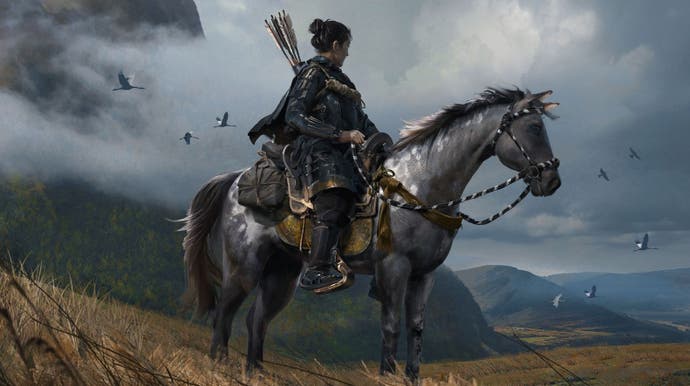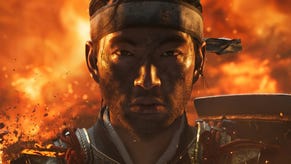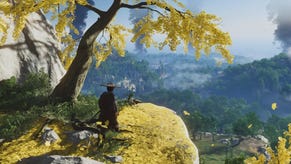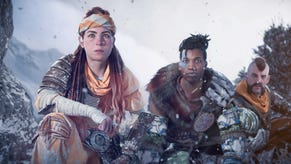Sucker Punch talks Ghost of Tsushima's inspirations, cultural authenticity, and the studio's growing identity
"It would have been immensely harder if we had not had the Japanese localisation team."
Ghost of Tsushima may not be the most groundbreaking of open worlds, but it sure is gorgeous, and with some stylish close-quarters combat Sucker Punch has still brought the traditionally breezy fun.
What's most interesting, of course, is the influence behind it. Sucker Punch and publisher Sony have leaned heavily on the film references, both in the marketing up to launch and the numerous nods in-game. Speaking before the game's launch to Sucker Punch's co-founder and producer Brian Fleming, along with art director and creative director on Ghost of Tsushima Jason Connell, what immediately interested me was how broad those influences were, as well as how deep that influence went. Has the studio tried to do more than just copy the look of mid-century samurai cinema? And how does such a distinctively American studio tackle the culture and history of Japan? The feudal era is one that's steeped in misconceptions, and Japanese culture as a whole can slip so easily into stereotype when replicated from the outside, I was intrigued to know how they bridged the gap. (Since this interview was conducted, there's also been a fantastic discussion raised around whether the game has gone too far in the other direction, playing into a more glorified idea of a complex point in time.)
There are lots of little things that hark back to previous games from the Washington-based studio, too, like some remarkably pretty particle effects and, interestingly, an above-average emphasis on getting the most out of the PlayStation 4's controller, so alongside the questions of cultural influence and sensitivity there was plenty more to talk about, from the studio's evolving DNA to its (largely still unsaid) plans for the PlayStation 5.
How much of some of your previous games like Sly Cooper and inFamous have made it over into Ghost of Tsushima?
Brian Fleming: I mean, obviously, the history of the company has been important in building the path of our corporate journey. And so sure, you know, I think those games and the people who worked on them do carry forward. But I think Ghost was also super transformative for the company because of its scale, the fact that it's melee based - all these things caused us to uproot a lot of that and rebuild it. But that's part of the reason we wanted to do new IP: to challenge ourselves to renew a bunch of what we're doing and to rebuild the company, to make it better, to make it stronger, to make it capable of doing this. The last thing I would say is, I think it's unequivocal that we could not have built Ghost - especially at our size, we never could have done that - had we not had those previous experiences to build on and ratchet ourselves up.
Do you feel there's an identity of what makes a Sucker Punch game at this point?
Brian Fleming: Yeah, I think so - and Jason, you should tackle this too. I think for me, the throughline on all those franchises is the feel of the controller in your hand and trying to get that to disappear so that it has this immersive quality - when you're in combat, it doesn't feel like you're pushing buttons. It feels like you're doing the action. I think that's something we've always viewed as one of the principle pursuits, trying to find a way to get the game to feel right. And I think that that began with Sly and continues into Ghost.
Jason Connell: That's that's the I think one of the ones that have stuck with Sucker Punch even long before I came here, it just being this very fluid experience. I would add over that though, all Sucker Punch games have always been artistically interesting or unique have an interesting style. As with our last game, and now especially moving into this game, I think that using the art and the graphical power to not just be like, 'Oh, that's good graphics,' but to stop you in your tracks and make you go, 'wow'. The last game it was pushing on the particle effects and making people go 'Holy shit, you can do that with particles? That's insane' to now using those particles, again in a completely new way to exaggerate the beauty of an island and the lighting and just really to make people stop and look at the world and be like, how did they do this?
I was going to ask about those particle effects, because it seems like one of the most obvious things to have carried over from inFamous.
Brian Fleming: I was gonna say, the VFX system is one of the iconic things that we brought forward! But the answer was getting a little long on that question! But certainly that is a great example of something where Ghost stands on top of the shoulders of that system that was built to do a superhero game. So it's incredibly powerful and put to great use in Ghost.
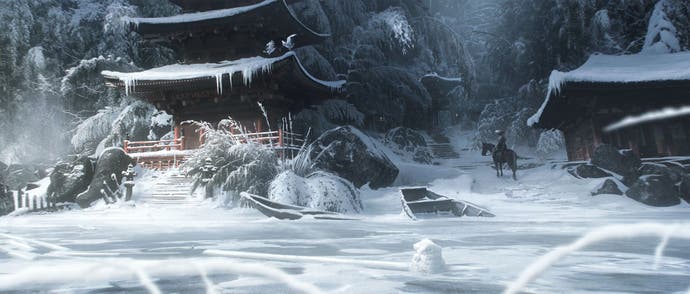
Has it been a challenge moving from the cartoonish side of things to photo realism - or a version of photo realism - with stuff like Tsushima? Has that changed how you've had to do things, in terms of say mechanics and the actual feel of it?
Brian Fleming: It's all part of the tone of the game, right? You know, the tone of the Sly Cooper games is exaggerated and cartoonish for a reason - the shading is cartoonish, the writing is cartoonish, it's part of a piece. Then you're making a superhero, which is a different genre. It's exaggerated, but maybe slightly less so than a cartoon. There are more grounded rules. Now we're making something that's even less exaggerated. I think of it as like you're learning to play music. And at the beginning, everything is kind of dramatic and exaggerated. But as you mature, and as your abilities get more refined, you can get more complex emotion out of the piano. It might be the exact same piece of music even, but you're able to play through the emotional content, rather than the mechanical content. So I do think we are able to communicate more sophisticated thoughts and emotions and feelings. That's part of our development as a studio.
You started this generation launching a game, and now you're closing it out by launching a game. Have they been quite different experiences?
Jason Connell: They're definitely very different experiences. And to piggyback off what Brian was saying earlier, the beginning is a little bit different because you have this new tech in front of you, you're trying to figure out how to utilise it as well as how to make a unique flavour for your game - inFamous: Second Son being that game. As we've progressed forward to this game, we did spend a bunch of time figuring out how to utilise tech to make this game, because it's a completely different game - you know, large scale terrain, procedurally generated and created forestry. We didn't have a lot of trees - our lead environment artists was talking about how they could probably count the amount of trees in our last game. And in this one there's just absolutely no way there's millions I don't know there's tonnes.
Brian Fleming: There's a number! It's three million trees.
Jason Connell: Three million trees! That's just insane you know, so you can't hand-place those, you have to develop tech in order to make that artfully and technologically work out. I feel like being towards the end is certainly super exciting. Obviously as creators you put a lot of pressure on yourself whenever you make a new IP.
Brian Fleming: I was talking earlier about the difference between jumping platforms and having a long sustained build on the PS4. In a lot of ways, I think we benefited because we weren't switching consoles. We made the transition to the new hardware on an existing IP and then did our innovation once we were across, and that may have actually helped us - I'd like to claim lots of credit for that brilliant tactical strategy. And we did think about it, but I think it worked out fairly well for us that we had a stable technical base, [so] as we had to reinvent all this we weren't also trying to adapt to new hardware.
How's development gone? Just generally speaking of crunch.
Brian Fleming: Well, I think that video games are tough to make. But I think we've done pretty well overall. The biggest challenge for us, of course was, at the end, we had to transition to work from home. And that certainly brought its share of problems. And I think probably the most stressful weeks involved trying to get everybody out of the studio because there were so much networking work to do and all that. The most acute crisis we faced was was really the transition to account for COVID.
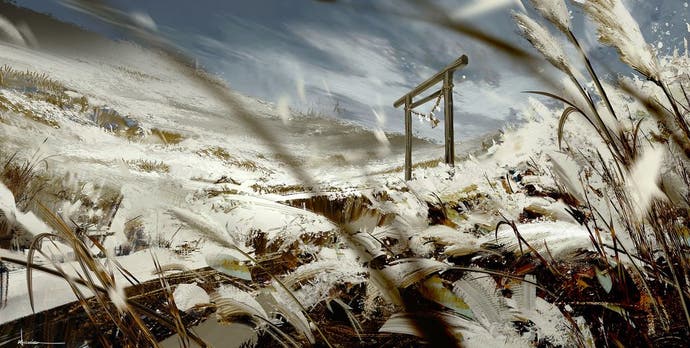
Obviously the PS5 is a big thing on the horizon. Is there anything you're particularly excited about as a studio, working with that as a new platform and the things that you can do?
Jason Connell: For me that I've been so incredibly focused on our current experience that I honestly haven't spent much time thinking about. I'm sure we'll find to get, you know, dig in there and, you know, talk about particles again, or something. It's gonna be an exciting time, I was one of the first artists that got to work on the PS4 and you know, the dev kits and all that. It was a really exciting time to try to develop those worlds. So it'll be great, but my head's been so into Ghosts of Tsushima and getting it out there and seeing what the world thinks that I haven't had much time to think about it.
Brian Fleming: If you're gonna be one of the final big titles on a console, you're kind of necessarily one of the trailing groups getting on to the next hardware and that's kind of where we are. That all said I think I'm particularly nerdily excited about haptic feedback in the controller. We talked about how we really love how controllers kind of connect [you to the game], and anything that gives us more ability to give the player better tactile feedback about what's going on I think will be a big deal. So I think for Sucker Punch, that's a particularly interesting area, right?
Yeah, for sure - I noticed that with Tsushima. You use a lot more of the controller, I guess is the way I would put it, than other games and I'm assuming lot of that comes with the territory of being first party?
Brian Fleming: I think about, you know, using the controller as a spray can holding it funny. You had to shake it or rattle it, I guess is the word they made us use to spray. We think this is a really important part of the experience. And so we spent a lot of time thinking about how we could use it, trying crazy stuff. And, you know, in the end, that's the point where the player touches the game. And so you put a lot of attention into it.
Jason Connell: It's kind of, it's like embedded studio philosophy, even little stuff like when you use the wind and it kind of comes through the little speaker in the controller. That was our audio guy. He just thought it'd be kind of cool. And that's utilising the controller in a totally different way. That's just this embedded philosophy that gets people to think that way.
I think I know what the answer is going to be to this question but have you got plans for putting Ghost on to the PS5, upgrading or anything like that?
Brian Fleming: We're desperately trying to make our ship date and survive the transition from our working on it to it becoming a real game - we'll get to PS5 and future stuff in the weeks to come!
That's fair enough - don't worry, I won't keep quizzing you on controllers and PS5! You've talked a lot already about inspirations, specifically cinema. 13 Assassins was one that came up with the combat in particular, and lots of Kurosawa, obviously. Do you feel like your goal is to make a game that is about samurai, or is it about samurai movies as a genre instead?
Brian Fleming: This is a cop out answer, but I think it has to be both. So much of our inspiration comes from samurai cinema - not just Akira Kurosawa, but just movies in general, including movies that were inspired by samurai movies like westerns, Star Wars, all these other different types of Western media that have been inspired by it. It's hard to divorce the two, right, because they're so embedded in the way that we think about samurai. Now there's obviously a huge side of what we're doing that's inspired by historical kind of things that may have happened, the types of armour that could exist in that time period that maybe you haven't seen in movies. So I think it's both.
What's been your approach to research? I know these are things you've talked about a bit already but I'm just wondering if you could elaborate a bit more on the specifics of bringing consultants in and how that worked.
Brian Fleming: We've hired consultants for various aspects of the game. Very early on we reached out to our Japanese partners, the Japanese localisation team that's worked on our previous games reviewed the game and reviewed the pitch. And they gave us some guidance early and extended the offer to help us come out to Japan and do a research trip - directors and some of the leads got to go out there on two separate trips. That was an incredible amount of research, photos and museums and getting to stand on Komodo Hama beach, the actual beach where the invasion happened. That's very, very real.
Subsequently over the years you hire consultants for script review and mannerism coaches when you're on vocab stage to try to understand the cultural differences - it's an important part of it. And then some of these some of these turn into great collaborations. The Japan audio team recorded birds and deer for us, so that we could actually put it to the game.
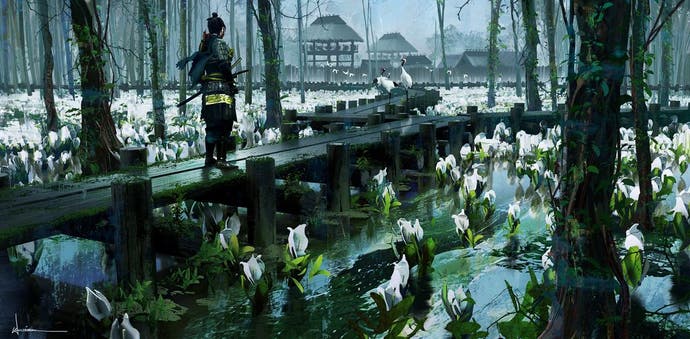
You're making this game as an American studio, and it's based on Japanese culture and Japanese history. Japan can be a difficult culture to nail from an outsider perspective - how have you tried to balance that?
Jason Connell: I think it would have been immensely harder if we had not had the Japanese localisation team that was helping us so much throughout the course of this project, even from very early on. It's certainly challenging, and I think I would say that it's challenging even when we created Seattle, right? [For inFamous]. This is our home. We live in the northwest, we live right outside Seattle, some of us. And so when we recreate that area, it's very easy to picture what it could look like, but even then you get into the conversation of like, 'Well, you know, this street looks like this, there's this building on the left'. It's like complete, utter realism, stone for stone. And we decided even for that game that we didn't want to do that. We wanted to create a feeling of being in Seattle, right? And so we wanted to do the same thing for this.
And it's way harder, right? Because it's in feudal Japan and the 13th century isn't something that's incredibly well-documented. It's very hard to understand exactly, even if you wanted to do stone for stone, it would be challenging. There's the balance between the game entertainment side, keeping people entertained, getting people excited about what they're playing, and the faithful representation that we got lots and lots of guidance on. But in the end, that's what our goal is: that faithful representation that is an enjoyable, fun experience for people.
Artistically speaking, are there any specific examples of something like artwork or antiques you used as inspiration for the game?
Jason Connell: As an artist, the thing that I tend to head towards is photography and lighting. I usually look at the lens of the world through an actual lens. I like to look at cinematography as references, which is one of the reasons we talk about samurai cinema so much, because it's the chief way that I view pieces of inspiration and how to translate that into our game. It's where the wind came from, you know - one of our very early art direction goals was everything should move. We didn't quite understand the mechanics of it yet, but we realised very, very early. Instead of just talking about contrast and colour and composition, we wanted to talk about movement because all of these films - especially Kurosawa - have movement in every frame. I did look towards Ran for colours and composition, look towards Yojimbo for characterisation.
When I went to Japan, I didn't know what a tsuba was before - I'd watched so many samurai movies but I didn't know what the little ring on a sword was, I didn't understand the exact terminologies. And when I went to Japan, we went to this little district that had all these antique shops, and we went to this one antique shop and they took us in the back. The person I was with was like, 'are you really interested in buying expensive old stuff?' and I was like 'Do you have anything from the 13th century?' and they just look at you and laugh, because no one has anything from the 13th century. But they had close to it! They had 14th century stuff - they brought these tsuba out, and I had only just learned what these were, and they had these antique beautiful dragons on them, and pampas grass on it. And they're just these super rare collectible items. And I was amazed at the artistry and the precision work that went into these. They're kind of patinated and old looking and they're heavy. And they are in very, very good standing - they stood the test of time. I was amazed and to see that up close, it's just amazing that somebody created these so long ago - it just brings a pure sense of like, how can I recreate that in a game and get people to feel those old, old, old textures? So that was definitely an inspiration for sure.

I guess it's part of the cyclical nature of these types of films, right, that they were inspired by westerns as much as the other way round - riding into a town and solving problems with your sword and all that sort of thing. Have you branched out beyond samurai cinema to draw inspiration?
Jason Connell: None that we continually talk about - I mean, there's like, Fistful of Dollars or something like that. And it's a remake of a Kurosawa film! That's the problem - many of these are either direct remakes and like just kind of change the name, or they're heavily inspired by them. So we just tend to just go straight toward the source.
Speaking purely artistically, I will say that there are games like Breath of the Wild and Shadow of the Colossus that I take a lot of inspiration from. They're both actually Japanese games, directed by Japanese teams, that have this great Japanese aesthetic to them. We wanted to go a little bit more grounded and photo real and really bring that feudal Japan out there. But there were things that we could draw from that like a little bit more minimal landscape.
Brian Fleming: I think an obvious inspiration for us is the first Red Dead game, too. You try out lots of different philosophies, and I'm certain that someone around here was like, 'Oh, yeah, it's kind of like the samurai Red Dead'. That is kind of a mental space that we occupied - clearly that had an influence on us!
